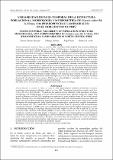Por favor, use este identificador para citar o enlazar este ítem:
https://hdl.handle.net/20.500.12958/3588| Título : | Variabilidad espacio temporal de la estructura poblacional, morfología y morfometría de Eisenia cokeri M.A. Howe, 1914 (Phaeophycea: Laminariales) en el nor-centro de Perú. |
| Otros títulos : | Spatio-temporal variability of population structure, morphology, and morphometric of Eisenia cokeri M.A. Howe, 1914 (Phaeophycea: Laminariales) in north-central Peru. |
| Autor : | Atoche Suclupe, Dennis Alemán Mejía, Solange Alexander Perea de la Matta, Ángel Uribe, Roberto A. |
| Palabras clave : | Eisenia cokeri;Macroalgas;Morfología;Estructura poblacional |
| Fecha de publicación : | sep-2021 |
| Editorial : | Instituto del Mar del Perú |
| Citación : | Atoche-Suclupe D, Alemán S, Perea A, Uribe R. 2021. Variabilidad espacio temporal de la estructura poblacional, morfología y morfometría de Eisenia cokeri M.A. Howe, 1914 (Phaeophycea: Laminariales) en el nor-centro de Perú. Inf Inst Mar Perú. 48(3): 414-429 |
| Citación : | Informe IMARPE;48(3), 2021 |
| Resumen : | El objetivo del estudio fue analizar la variabilidad espacio-temporal de la estructura poblacional, morfología y morfometría de Eisenia cokeri en el nor-centro de Perú. Los muestreos se realizaron en marzo y agosto 2018, febrero y julio 2019, en siete localidades a lo largo de ≈50 km en la Región Áncash. Se realizaron buceos para estimar densidad y biomasa y fuera del agua, mediciones individuales para registrar morfología y morfometría de cada alga. Durante los cuatro tiempos de muestreo se contó
10.913 algas distinguiendo cuatro patrones morfológicos denominados estados de desarrollo. La densidad
total de E. cokeri varió de 2 a 64 algas/m2 con promedio de 15 algas/m2 , la biomasa varió de 578 g/m2
a 39.288,6 g/m2. Respecto a la morfología, el estado de desarrollo cuatro presentó mayores frecuencias durante todos los muestreos. La longitud total máxima fue 299 cm con promedio de 123 cm, el diámetro mayor del rizoide
máximo fue 42 cm con promedio de 12,6 cm. La mejor variable explicativa del peso fue la longitud total. E.
cokeri no presentó patrones de variabilidad temporal y espacial de su estructura poblacional, morfología
y morfometría en la región Áncash. Futuros estudios son necesarios para conocer su historia de vida y
dinámica reproductiva. Los resultados resaltan la importancia de E. cokeri como especie formadora de hábitat
dominando el submareal rocoso somero. Debido a su vulnerabilidad y restringida distribución de estos
bosques, E. cokeri debe ser considera una especie protegida. ABSTRACT: We analyzed the spatio-temporal variability of the population structure, morphology, and morphometrics of Eisenia cokeri in north-central Peru. Between March and August 2018 as well as February and July 2019, sampling was conducted at seven localities along ≈50 km in the Áncash Region. Through dives, we estimated density and biomass, while individual measurements were taken out of the water to record the morphology and morphometry of each plant. A total of 10,913 algae were counted throughout all sampling periods, being identified four morphological patterns called stages of development. The total density of E. cokeri varied from 2 to 64 plants/m2 with a mean of 15 plants/m2 and the total biomass varied from 578 g/m2 to 39288.6 g/m2 . Developmental stage four showed the highest frequencies in terms of morphology during all samplings. The maximum total length was 299 cm with a mean of 123 cm, the maximum major diameter of the rhizoid (MDR) was 42 cm with a mean of 12.6 cm. The best explanatory variable for weight was the total length. In Áncash, E. cokeri did not present patterns of spatio-temporal variability of its population, morphological, and morphometric structure. Further studies are required to know its life history and reproductive dynamics. The results show the importance of E. cokeri as a habitatforming species dominating the shallow rocky subtidal, so given its vulnerability and restricted distribution in these forests, it should be considered a protected species. |
| URI : | https://hdl.handle.net/20.500.12958/3588 |
| ISSN : | 0378-7702 |
| Aparece en las colecciones: | Informe vol. 48(3) 2021 |
Ficheros en este ítem:
| Fichero | Descripción | Tamaño | Formato | |
|---|---|---|---|---|
| Informe 48-3 articulo8.pdf | 4,13 MB | Adobe PDF |  Visualizar/Abrir |
Este ítem está sujeto a una licencia Creative Commons Licencia Creative Commons

